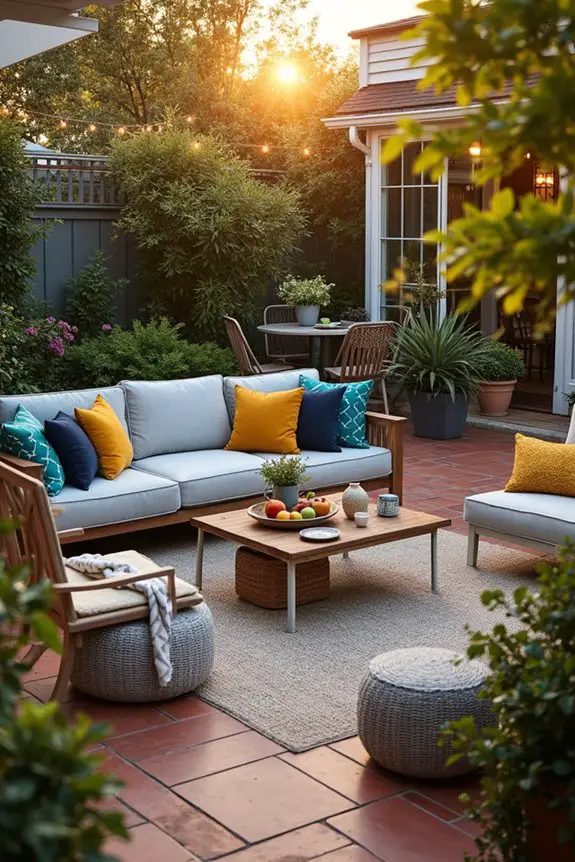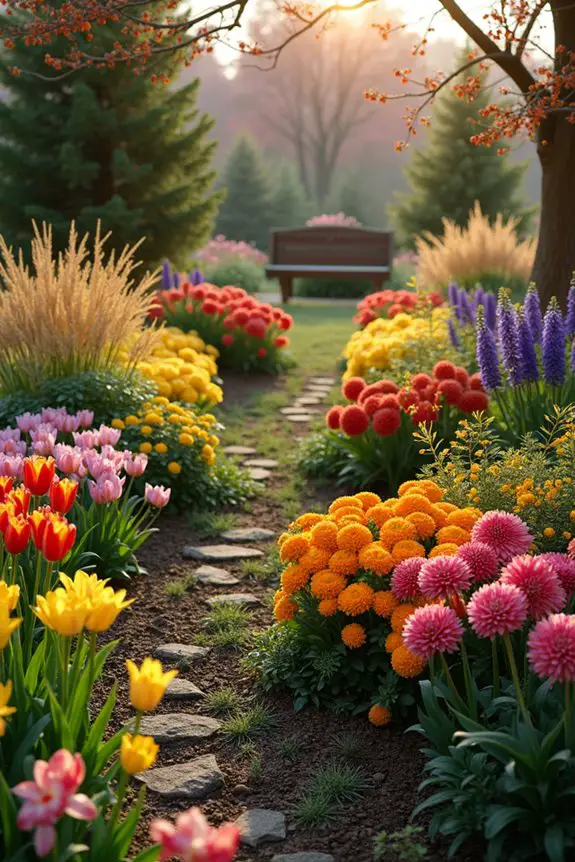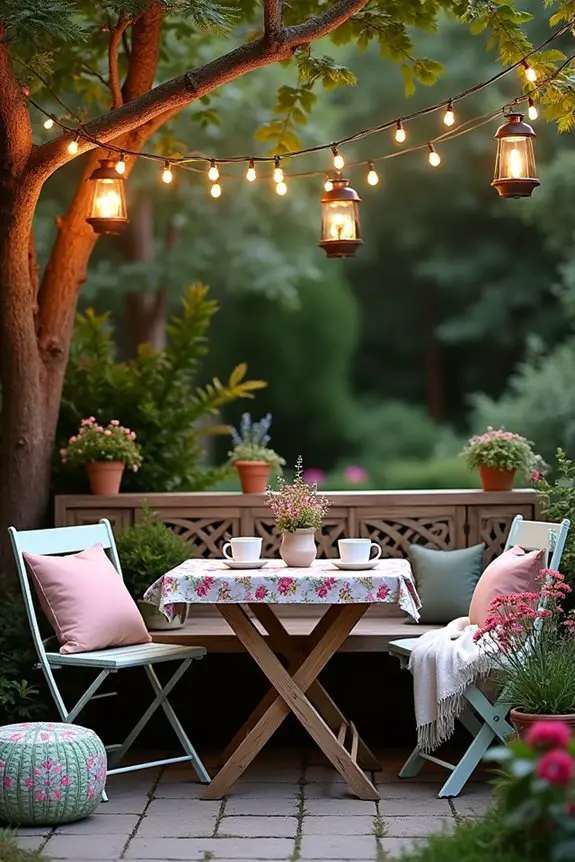You know how in movies, the rooftop terrace is always the setting for deep conversations and unexpected romance? Well, it’s time to make your own outdoors just as enchanting. Picture vibrant vertical gardens, cozy furniture arrangements, and maybe even a tranquil water feature. Got a small space? No problem. You’ll want these ideas to transform your abode into a stylish retreat. Ready to plunge into the details of tomato plants mingling with daisies? Let’s get started.
Creative Layout Inspirations
When it comes to creative layout inspirations for your terrace garden, the possibilities are endless.
Picture vertical garden concepts that make use of limited space, or geometric planter arrangements that give your greenery a playful edge.
Plus, don’t forget how colorful plants can light up your space; it’s like giving your garden a personality—what vibe are you going for?
1. Vertical Garden Concepts
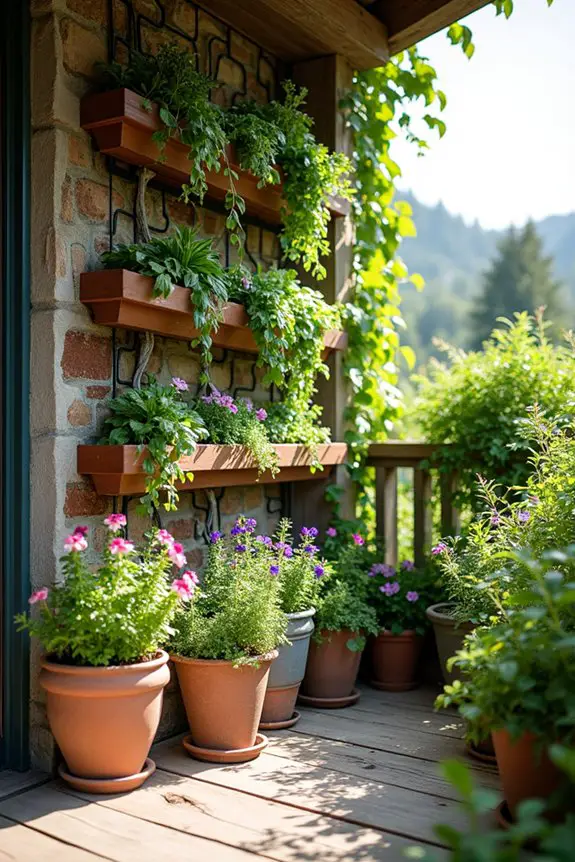
When it comes to enhancing your terrace garden, vertical gardening is both a genius and stylish solution. Not only does it save space, but it also creates a lush, greenery-filled atmosphere that instantly lifts your spirits. Imagine stepping outside to a wall of vibrant plants, all climbing toward the sky like they’re keen to greet the sun. It’s like having a little slice of nature right at your fingertips, and trust me, that feels pretty magical.
To immerse yourself in the vertical garden trend, start by choosing the right kind of structure. You can use trellises, wall planters, or even repurpose old pallets for a rustic touch. If you’re feeling ambitious, try creating a living wall using modular planting systems that let you mix and match different types of plants.
My own attempt at this involved a lot of wrestling with the plants, some questionable climbing skills, and an impressive collection of dirt on my pants. Spoiler alert: I survived, and my plants thrived.
For picking plants, consider using trailing varieties like ivy or pothos, or vibrant flowers like petunias to drape beautifully down your vertical canvas. Herbs are another fantastic choice—think about a wall of basil, mint, and cilantro—yum!
Remember to choose plants according to the amount of sunlight in your terrace. Do a little light-checking dance (which, I assure you, will be comically awkward), because some plants thrive in full sun while others prefer a shadier spot.
When it comes to watering, don’t forget that plants in vertical gardens may need more attention than their lowly counterparts. Installing a drip irrigation system can be a game-changer. It’s like a spa day for your plants, ensuring they get just the right amount of water without requiring you to engage in any back-breaking watering can workouts.
And please, check that they’ve good drainage; no one wants plants drowning in their effort to thrive.
Lastly, don’t shy away from adding personal touches like decorative pots or colorful plant labels. This will truly make your vertical garden feel like an expression of you.
And here’s a tip from someone who’s learned the hard way: take your time arranging the plants. It’s okay to move things around until it feels just right. After all, it’s about creating a green sanctuary that makes your heart smile.
2. Geometric Planter Arrangements
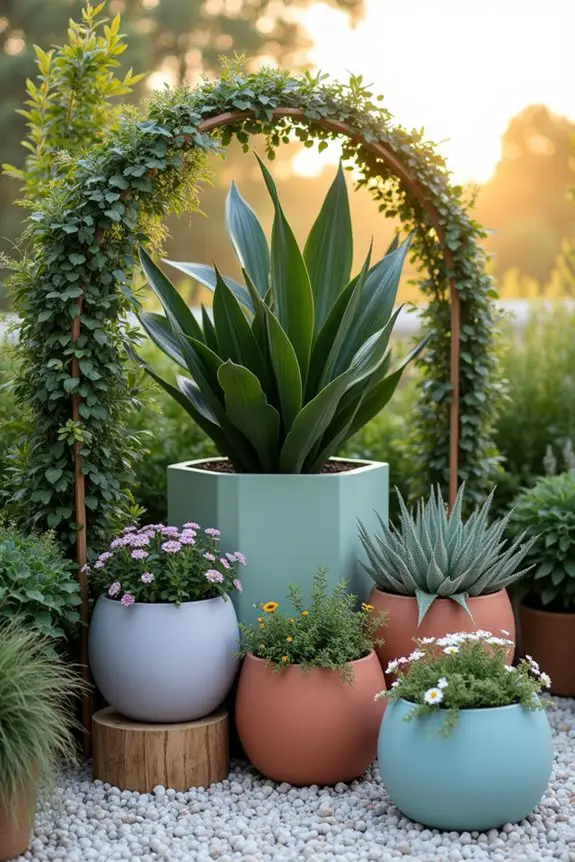
When breathing life into your terrace garden, geometric planter arrangements can be a game-changer. They not only maximize your available space, but they also introduce a sophisticated, modern flair to your outdoor area. Think of those perfectly arranged planters as a creative puzzle, each piece fitting together to create a stunning visual treat that you can enjoy every day. Plus, who doesn’t love a little challenge when designing their green oasis?
To get started, gather a variety of planters in different shapes and sizes—think squares, rectangles, circles, and even triangles. The key is mixing and matching these geometric shapes to create an eye-catching display. Consider placing taller planters at the back or center of your arrangement, gradually moving to shorter ones in the front. This not only adds depth but makes sure that every plant can bask in the sunlight without being overshadowed by its taller neighbors. An elegant garden arch can also provide an appealing focal point to complement your geometric designs.
As for the plants, go wild with a mix. For instance, you can pair tall, spiky plants like snake plants or dracaenas with more rounded options like peace lilies or succulents that peek out from the edges. The juxtaposition of shapes will create a playful visual dynamic.
Now, if you’re scratching your head about color coordination, fret not. Nature is a master at combining colors, so aim for a balance, mixing dark greens with colorful blooms or textured foliage to spice things up.
Here’s a little pro tip: when arranging your planters, don’t be afraid of height variances. Use risers—like stacked books or wooden blocks—to elevate certain planters. This can create dramatic layers while adding a touch of whimsy to your garden.
And if you’re feeling particularly adventurous, you could paint your planters in complementary colors to tie everything together. Just imagine—your once bland terrace transformed into an art installation that even your neighbors might envy. Just be careful not to get splatters of paint on yourself like I did; it turns out, I’m rather clumsy with a paintbrush.
Now, let’s talk placement. Try to visualize how you’ll enjoy your garden. You may want your geometric arrangement to be in a spot where you can kick back and soak in the beauty. That means arranging your planters to allow for comfortable seating while placing the tallest ones somewhere less obstructive—no one wants to sacrifice their view for the sake of greenery, right?
Lastly, don’t forget regular maintenance. Geometric planter arrangements can be a bit tricky, with the plants possibly gripping for space. This means you’ll want to carefully monitor their growth and adjust their positions as needed.
Also, consider installing a deer fence around your garden to protect your plants from unwanted munchers. Trust me, I’ve had my fair share of the “too tight squeeze” catastrophe—when plants decide to play tug-of-war for growing space. A little pruning goes a long way in keeping things looking neat and promoting healthier growth.
3. Colorful Plant Selection
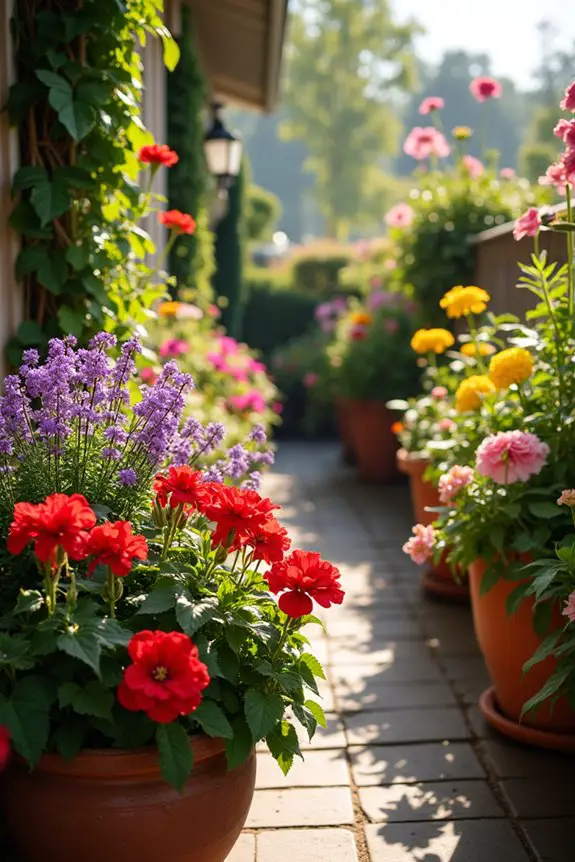
Adding colorful plants to your terrace garden is like splashing a bright canvas with paint—it instantly transforms your space while providing lush vibrancy. Not only do these lively hues lift your mood, but they also create visual interest that’s sure to wow your guests. Visualize soaking up the sun surrounded by a spectacular palette of greens, reds, purples, and yellows. Sounds inviting, right? Consider using terracotta pots set to enhance the beauty of your plants while also providing excellent drainage.
To get started with your colorful plant selections, consider mixing annuals and perennials. Annuals are a fun way to experiment with seasonal blooms that change every year, like petunias and marigolds. On the other hand, perennials such as daylilies and coneflowers come back time after time, establishing a reliable burst of color. So, why not plant both? Envision a wave of petunias spilling onto the edge of your terrace while a backdrop of sturdy coneflowers boldly stands tall. Together, they create a cohesive, dynamic look.
When selecting your plants, think of colors that complement each other. For instance, a mix of purple and yellow can create a cheerful contrast, while orchestrating a blend of pinks and whites evokes soft, romantic vibes. To make your plant layout pop, use color wheels for inspiration—like pairing warm colors (reds, oranges) with cool colors (blues, purples) for drama.
Feeling unsure of your choices? No worries. It’s perfectly okay to start small and add as you go; kind of like adding spices to a soup, you can taste as you create!
Placement is essential, too! Aim for groups of the same color or contrasting colors clustered together for a guy-would-have-been-impressed impact. For example, placing a bunch of fiery red geraniums next to lush green foliage instantly draws the eye. Did I mention height? Try to layer your plants from shorter in the front to taller in the back. That way, everyone gets their moment in the spotlight, including the delicate flowers hiding just below the bigger leaves.
Don’t forget about variety in foliage as well. You can contrast colorful blooms with vibrant leaves, like the striking foliage of a caladium or a dark, almost black, ornamental sweet potato vine. Trust me, the juxtaposition can really elevate your garden. Plus, it gives you more to work with when you’re trying to decorate your space—think of how it draws your guests in, encouraging them to inspect each detail.
Oh, and here’s a little personal tip: be prepared for color overload! Last time I picked plants based solely on their vibrant colors, I ended up with a rainbow explosion that even a parrot might dread. It turns out that sometimes, less is more.
Just keep in mind why you love your terrace— is it a relaxing escape or a lively gathering spot? Tailor your plants to fit the vibe you want, and you’ll craft the perfect space to retreat to after a long day. Also, using stylish plant labels and markers can help you keep track of your diverse plant choices.
4. Lighting for Ambiance
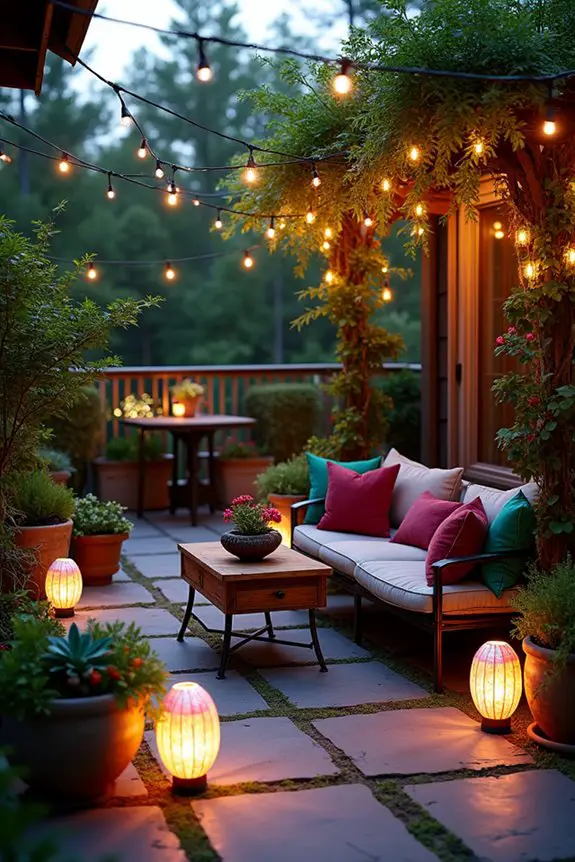
When it comes to terrace garden design, lighting is like the magical sprinkle on top of your favorite dessert—it elevates everything and creates an inviting atmosphere. Good lighting not only showcases your beautiful plants and decorations, but it also sets the mood for cozy evenings or lively gatherings with friends. Imagine enjoying a warm summer night relaxing under the soft glow of twinkling fairy lights. Doesn’t that sound dreamy?
So, let’s explore how to light up your terrace garden effectively. First off, think about the purpose of your lighting. Are you aiming for a romantic vibe, a festive gathering space, or a functional area for evening gardening? Identifying your goal will help guide your choices.
Start with string lights. They’re like the bread and butter of outdoor lighting—easy to install, versatile, and whimsical. Drape them along railings, wrap them around tree branches, or hang them overhead, strung between poles. The warm glow they emit adds charm, and you can find them in various colors.
Just be careful not to drape them around your plants too tightly; you don’t want to accidentally create a plant choking hazard.
Next, consider solar lanterns. These handy little guys charge during the day and light up automatically at night. They come in all shapes and sizes, so you can pick ones that match your garden’s theme. Place them along walkways or hang them around seating areas for a delightful glow.
Plus, you won’t have to deal with any cords—bonus. Just don’t forget to give them a little space from your planters so they can soak up that golden sun.
For a bit of drama, think about adding spotlights. These are great if you have a favorite plant or feature you want to highlight. Installing them lower to the ground and angling them upwards can create an alluring effect, making your plants look like they’re on stage for an award show.
Don’t forget to position them carefully; you want to avoid creating shadows that might make your plants look spooky.
Don’t be shy about mixing different types of lighting. A combination of string lights, lanterns, and spotlights can create layers of ambiance that keeps things interesting. It’s like mixing different flavors in a dish—each adds a little something special.
Just remember, balance is key. You don’t want it to feel like a disco party unless that’s your goal. Outdoor throw pillows can also complement your lighting by adding comfort and style to your seating areas.
Lastly, as someone who overdoes it on occasion (may have had one too many fairy lights on last year’s patio), keep in mind that less can certainly be more. Try starting with a few pieces and tweak as you go.
Add a little here, shift a little there, and soon enough, your terrace will be transformed into a magical refuge.
5. Natural Materials Integration
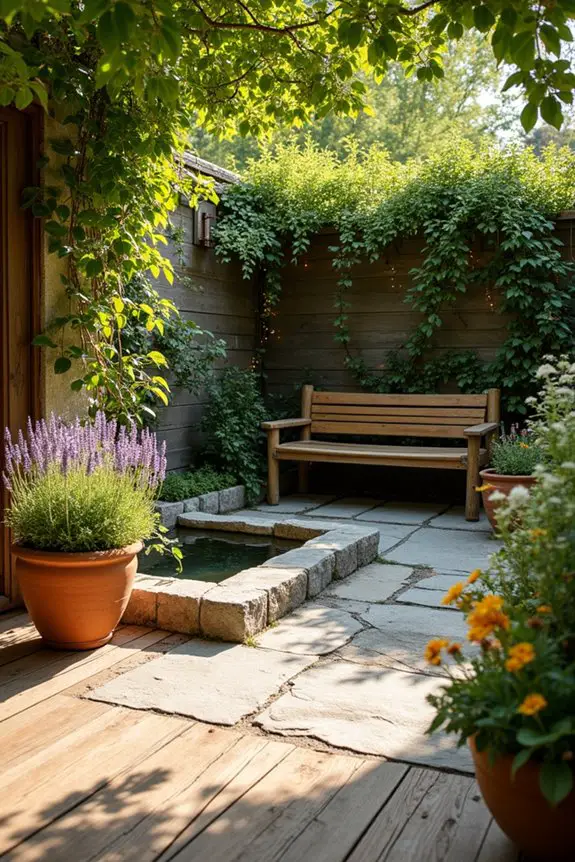
Creating a terrace garden that truly feels like an oasis requires more than just pretty plants; it’s about harmonizing with nature through the materials you choose. Integrating natural materials can transform your space into a serene retreat, exuding a rustic charm that helps you unwind after a long day or provides the perfect backdrop for a weekend barbecue. Plus, using natural materials often means they blend seamlessly with your plants, enhancing their beauty and overall vibe. Who doesn’t want that?
First things first, let’s talk about the foundation of your terrace garden. Wooden decking or a stone pathway can make all the difference. If you’re leaning toward wood, consider using reclaimed wood for a stylish and eco-friendly choice—think about that character and history it brings to your space. Lay down the planks in a staggered pattern to create visual interest and avoid the uniform look of a bare floor; it’s like adding a touch of flair to your favorite dish.
If you choose stone, opt for uneven slabs or natural flagstones that can offer a more organic feel. A mix of textures can add depth and make your garden feel inviting, almost as if it’s whispering secrets of nature.
Next up, how about incorporating natural stone planters or terracotta pots? It’s an easy way to let your flowers and greenery shine while staying true to a nature-inspired theme. Stack a few rocks to form a rustic pond or create a cool seating area with rough-hewn stone benches. Just make sure that whatever you pick provides good drainage—no one wants a soggy garden that ends up looking more like a mud pit than an oasis.
Here’s a pro tip: if you’re not too attached to your current seating arrangements, try replacing them with a sturdy log bench. You’d be surprised how cozy it feels, and it can bring that forest feel to your urban terrace.
Don’t forget about incorporating living elements into your natural design. You could create vertical gardens by mounting wooden frames covered in climbing plants. This not only saves space but also adds brilliant greenery, offering a liveliness that can easily distract from the hustle and bustle of city life.
Let those vines twirl and twist around the frame; it’s like nature’s own artwork, and trust me, you’ll feel like a proud plant parent every time someone admires it. Plus, they can help insulate your terrace from heat, knocking down the temperatures so you can sip iced tea in comfort, instead of melting into your chair like that last scoop of ice cream on a hot day.
To wrap it all up, using natural materials isn’t just about how your terrace looks; it’s about how it feels too. Embrace the texture, colors, and organic shapes; there’s beauty in the imperfect.
Your terrace will become a peaceful sanctuary, and you might just find yourself spending a whole lot more time outside, perhaps plotting your next gardening masterpiece or simply enjoying a good book while surrounded by that lovely earthy vibe. Who knew creating a green getaway could be this fulfilling?
6. Sustainable Plant Choices
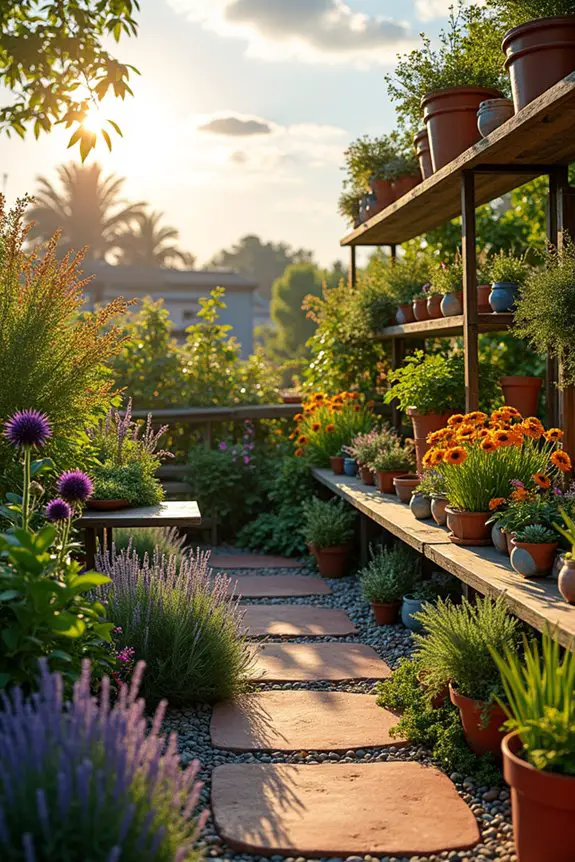
When it comes to creating a stunning terrace garden that’s both beautiful and practical, choosing sustainable plants is like picking the ripest fruit at the market—rewarding and impactful. Not only can these flora selections thrive with minimal fuss, but they also fill your garden with lush, green beauty while being easy on the planet.
Sustainable plants encourage biodiversity, provide habitat for local wildlife, and even save you some cash in the long run because they require less water and maintenance. It’s a win-win, right?
First things first, take a little time to research plants that are native to your area. Native plants are like local chefs who know their ingredients best; they’re already adapted to your climate and soil, so they’ll flourish with less care and fuss. Plus, they often attract local pollinators like bees and butterflies, adding an extra dash of life to your garden.
Imagine sipping your morning coffee while watching a parade of pollinators dance around your flowers; it’s a beautiful way to start the day.
Next, think about layering your plant choices. Mix tall grasses or flower stalks, like goldenrod and coneflower, with mid-sized blooms such as black-eyed Susans, and low-growing ground covers like creeping thyme.
Layering not only creates visual interest, but it also helps with natural pest control and provides various heights, making your garden feel fuller and more inviting. Picture your terrace as a multi-tiered cake: each layer adds richness and depth, making it far more delicious than a flat slab.
Now, let’s sprinkle in some hardiness. Incorporate drought-resistant plants, like lavender or succulents, which will keep your garden looking fresh without requiring a daily drink.
These resilient beauties thrive on neglect (trust me, I totally relate) and let your green thumb take it easy. Place them in sunny spots for maximum effect and watch them flourish like they’ve been given a standing ovation. Plus, their unique shapes and colors can add an artistic flair to your design.
A fun tip for accessibility and aesthetic appeal: group plants according to their watering needs. Create zones in your garden where you can place thirstier varieties together and keep the drought-tolerant ones in a separate area.
This method not only helps with watering efficiency but also creates natural divisions that guide the eye around the space. Add colorful stones to delineate these areas—think of it like giving each plant group its own VIP section.
Finally, don’t forget to include some edible plants. Herbs like basil, thyme, and parsley are excellent companions to your flowering plants. They’ll not only add a delightful scent but also offer tasty ingredients for your next culinary experiment.
I mean, what better way to impress dinner guests than by saying you grew the herbs right outside, right?
7. Seasonal Theme Inspirations
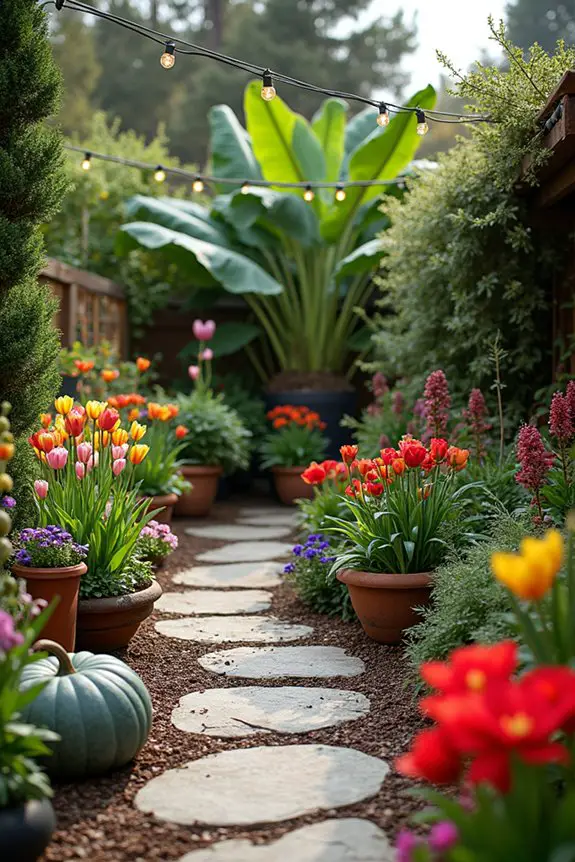
When it comes to terrace gardens, embracing the seasons can breathe new life and excitement into your green space. Imagine stepping onto your terrace and feeling like you’ve traveled through the changing seasons, each corner offering a new experience. A seasonal theme not only keeps your garden fresh and interesting, but it can also guide your plant choices, layouts, and colors. Who wouldn’t want their own miniature seasonal escape right at home?
First up, consider the beauty of Spring Fever. Picture brilliant blooms like tulips and daffodils bursting forth, their colors as cheerful as a sunny day. To create this look, plant early flowering bulbs in the fall, so they can surprise you when you least expect it. Layer them with vibrant annuals like pansies and petunias that can handle the cool early temperatures.
Ah, don’t forget to add some fragrant herbs, such as mint or chives, which not only look great but are also practical for your spring salads. A tip? Group your flowers in clusters, like nature’s confetti, and don’t be shy about planting in odd numbers—they create a more natural feel.
Once summer rolls around, it’s time to turn up the color with a Tropical Paradise theme. Think about incorporating plants like colorful hibiscus, banana trees, and dramatic elephant ears. These bold choices offer a lush ambiance and scream “vacation vibe” to anyone who steps on your terrace.
Place them in large pots, and let some spill over the edges for that casual, carefree look—just like when you forgot to tidy up after a beach day. A pro tip? Use trellises or vertical planters for climbing vines like sweet peas or morning glories. They’ll not only save space but also create a stunning backdrop that’s like a green curtain ready for a summer show.
As the crisp air of fall approaches, consider a Harvest Festival theme that showcases the achievements of your summertime garden. Plant colorful kale, ornamental peppers, and late-blooming asters for a fun, festive flair. Don’t forget that pumpkins can add a playful touch, plus they look adorable nestled among the flowers.
Think of clustering your pumpkins and plants together—it’s like setting up a cozy autumn picnic spot right on your terrace. And hey, you can even use leftover pumpkins for soup later, making it a double win in both decor and dinner.
Then, as winter takes hold, shift to a Winter Wonderland by incorporating evergreen plants like hollies and pines that maintain their beauty even in the cold. Decorate with twinkling strings of lights to create a magical nighttime scene that shines brighter than your family’s Christmas sweater contest (we all know how that goes).
For visual interest, think about adding some berries or winter-blooming plants like winter jasmine to keep things lively. And here’s a helpful tip: use sturdy planters filled with gravel to guarantee good drainage, letting your winter beauties stand proud without getting too soggy.
Embracing seasonal themes not only keeps your terrace looking fresh and vibrant throughout the year, but it also gives you a chance to be creative and have a little fun. Mixing colors, textures, and plant varieties will surely keep your space inviting.
After all, who doesn’t enjoy a garden that offers a fresh experience with each seasonal change? It’s like creating a mini-vacation destination—right at home.
8. Mood-enhancing Color Palettes
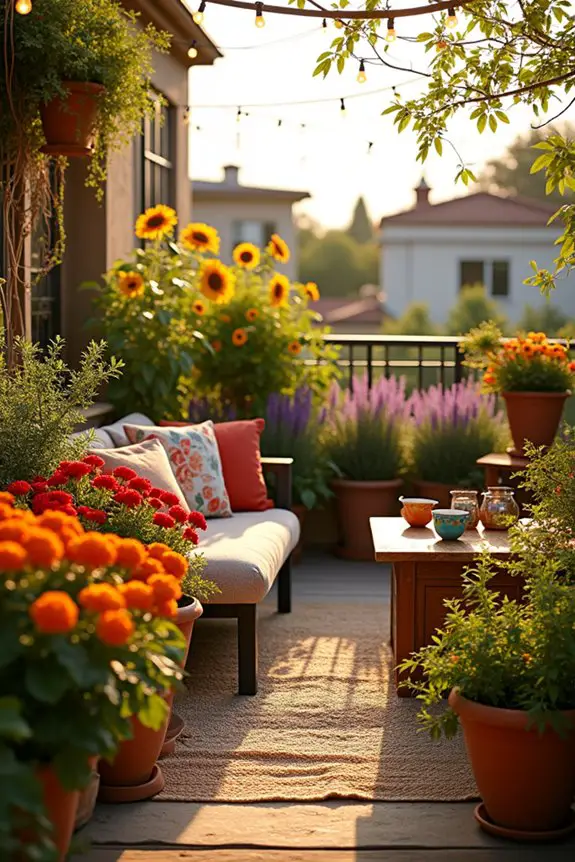
When it comes to creating a mood-enhancing terrace garden, color palettes can be game-changers. A carefully chosen color scheme not only makes your space visually appealing but also sets the tone for relaxation, joy, or even a little bit of drama. Imagine stepping out onto your terrace and being instantly uplifted by vibrant hues or calmed by serene tones. That’s the magic of color working its wonders on your mood and ambience.
Let’s explore how you can curate these inspiring color palettes for your terrace! Start by choosing a central color that resonates with you. For a calm, soothing vibe, consider soft blues and greens. Think of nestling delicate lavender flowers next to lush ferns, creating a serene oasis.
On the flip side, if you’re looking to inject some energy and excitement, vibrant yellows and oranges can do just that! Picture golden marigolds mingling with fiery red geraniums; that combo could be the perfect wake-up call for any space.
Once you have your base color sorted, think about adding contrasting or complementary shades to enhance the visual interest. This means if you’re going with those cool blues, think of adding pops of bright white or even some dark purple accents to really make the garden sing. Make it feel layered and dynamic, like a beautiful painting that draws the eye in!
A little tip here: when selecting plants, consider their blooming seasons too. You want to keep the color flowing throughout the year. For instance, while your spring daffodils shine bright, don’t forget about those summer petunias and autumn chrysanthemums that would add to your color story as the seasons change.
Now, let’s talk about placement. This is where you can really get creative! Think about using pots of various heights. Taller plants behind shorter ones create layers that add depth and intrigue.
If you tend to struggle with spatial organization (like me, the self-proclaimed “potting disaster” of my neighborhood), try grouping your plants in threes or fives— it just looks more harmonious. Oh, and don’t forget the art of repetition—using the same color in multiple spots can help tie the whole garden together nicely.
And here comes the fun part: accessorizing. Use cushions, outdoor rugs, or even colorful dinnerware that match your color scheme. It’s like adding sprinkles to your cake, just a little finishing touch to make it all come together.
Whether you prefer a cozy lounge feeling for evening stargazing or an energetic vibe for brunch with friends—incorporating these colors boldly will make your terrace garden your personal paradise.
9. Water Features Integration
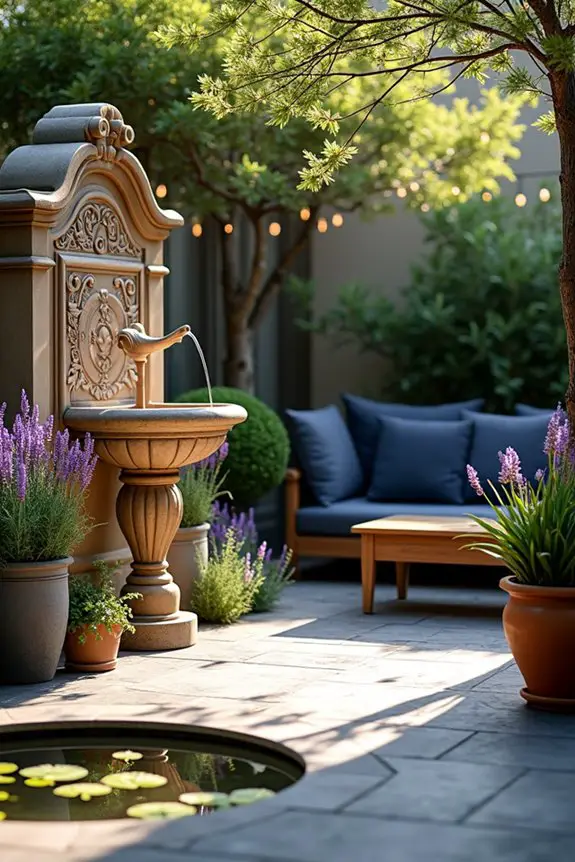
When it comes to terrace gardens, adding a water feature can elevate the entire space, bringing in an element of tranquility and sophistication. The gentle sound of flowing water can soothe stress away while creating a serene backdrop for relaxing or entertaining.
So, how can you seamlessly integrate a water feature that complements your garden’s vibe? Let’s explore, shall we?
First, decide on the type of water feature that speaks to you. Are you dreaming of a classic fountain that adds splashes of elegance? Or maybe a small pond teeming with life is more your style. Even a portable tabletop fountain can deliver a little zen without taking up much space, perfect for those of us who are a bit spatially challenged (guilty!).
Visualize how the water feature will interact with your plants and seating arrangements—this sight can be incredibly inviting.
Now that you’ve chosen the type of water feature, consider its placement. Ideally, you want it in a spot where it can be admired from various angles. Maybe next to your cozy lounge area or even as a focal point in the center of your terrace. Whichever you choose, make certain it’s visible enough to draw the eye without overwhelming the other elements around it.
It’s all about balance, right? Also, verify that your feature gets some sunlight. Sunlight can make the water shimmer and sparkle!
If you opt for a fountain or pond, think about the plants you’ll use to frame it. Tall grasses or soft ferns can create beautiful layers that wrap around the water without overshadowing it.
And here’s a golden nugget of advice: use water-loving plants like water lilies in your pond, or opt for potted lavender around a fountain to make the whole area fragrant, adding a sensory delight to your oasis.
Now, let’s talk about maintenance because, let’s be honest, we’ve all had that one potted plant that just wouldn’t cooperate and ended up looking like a sad little twig (not speaking from experience or anything).
Make sure to regularly check the water level, especially during hot spells, and clean the fountain or pond to keep it looking fresh and lovely. Your goal is to create a serene escape, not a science experiment gone wrong.
Lastly, don’t forget about lighting! Soft, warm lights around your water feature can create an enchanting atmosphere in the evenings. Picture sipping your favorite drink with friends, under twinkling stars, while the water dances in the moonlight—it’s the type of vibe we all secretly dream of, right?
10. Furniture Arrangement Techniques
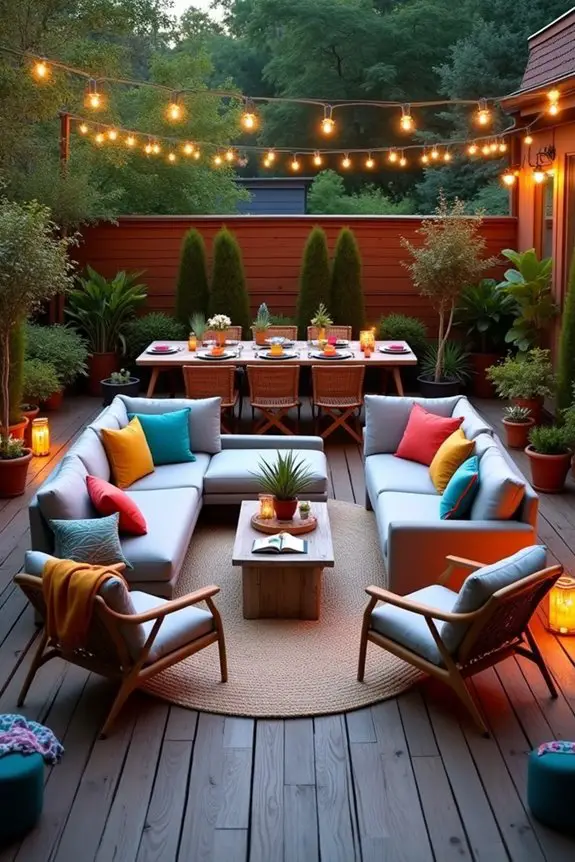
When it comes to terrace gardens, furniture arrangement plays a significant role in creating a welcoming atmosphere, and it’s more than just shoving a few chairs and a table together. A well-thought-out layout can maximize both space and comfort, making your outdoor oasis a favorite hangout spot.
So, how can you achieve that perfect balance of functionality and style? Let’s explore some creative layout inspirations that will transform your terrace into an enchanting retreat.
First things first, think about your activities. Are you looking to host lively brunches with friends, or do you prefer quiet evenings with a good book? Your furniture arrangement should cater to these desires.
For casual gatherings, create a circular seating layout; it fosters conversation and makes everyone feel included. Imagine this: a cozy sectional or a few chic lounge chairs arranged in a way that encourages eye contact—this cozy circle is perfect for sharing stories (or juicy gossip, if you’re feeling spicy).
Now, if your space is a bit narrow or limited, try utilizing a long, rectangular dining table that runs parallel to the edge of your terrace. This creates an inviting dining area with ample room for delicious dishes and plenty of elbow space without feeling cramped.
Don’t forget to leave a walkway at least two feet wide for easy navigation; that way, you won’t be dodging chairs like you’re in a game of dodgeball when you refill the drinks.
Another clever way to maximize space is by incorporating multifunctional furniture. Look for ottomans that double as storage or nesting tables that can be tucked away when not in use. These pieces are total game-changers; they keep the area tidy while offering flexibility.
Remember that time you tripped over a random stack of cushions because you didn’t know where to put them? Yeah, let’s avoid that debacle.
And speaking of cushions, add extra textural layers with soft pillows and throws. Not only do they make your seating areas super comfy, but they also introduce pops of color to liven up the space.
Think of it as dressing your outdoor furniture in the coolest, most fashionable attire. Use a mix of patterns and materials to keep things interesting, but aim for cohesion; otherwise, it feels like a party where no one knows the host (awkward, right?).
Lastly, don’t overlook the importance of pathways and flow. You want your terrace to feel open and accessible, with a clear movement for guests to enjoy the space.
Arrange furniture to create a natural flow that guides people from one gathering spot to another. Consider wind direction too; facing your seating area away from the breeze can keep pesky napkins and hairdos intact during those breezy afternoons.
Effective Soil Preparation
Before you dive headfirst into planting your terrace garden, getting your soil prepped is more essential than you might think.
Think of soil as the cake batter— without a solid base, your plants won’t have a chance to rise. First, gather quality potting mix and sprinkle in compost like you’re adding sprinkles to ice cream. It adds nutrients that plants crave.
Soil is your plants’ cake batter—without it, they can’t rise! Mix in quality potting mix and nutrient-rich compost for a thriving garden.
Don’t forget to check for drainage; nobody wants soggy roots in their urban oasis. Mix it all together with a garden trowel, and let’s be real, it’s a workout.
Pat yourself on the back, because a little soil magic can turn your terrace into a vibrant paradise.

